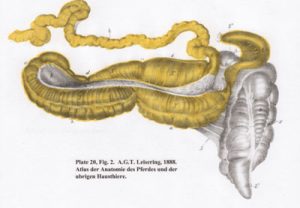Equine Colic Types
Large colon lesions
 Predispositions to disease
Predispositions to disease
Minimal fixation allows movement – colonic torsions and displacements are common
Gas production during microbial digestion may cause colic (gas distension; displacement)
Hairpin turns and changes in diameter create sites prone to impaction
Clinical signs
Large colon disorders typically lead to abdominal distension (bloat) and abnormalities on rectal examination (impactions, gas, displacements).
Colic signs can range from mild to severe and depend on the amount of gas distension and tautness of the mesentery.
Fecal production is typically minimal. Mucus covered feces indicates the presence of an obstruction (may or may not be resolving).
Two types of large colon disorders can reflux: nephrosplenic entrapments and small colon impactions. We believe the colon lesions are pinching the duodenum shut, creating a secondary SI obstruction.
Ultrasound can be challenging. While reports suggest you can detect sand on ultrasound, it looks very similar to gas. Edema of the mesentery can indicate a torsion.
Radiographs can be performed to check for sand and enteroliths.

